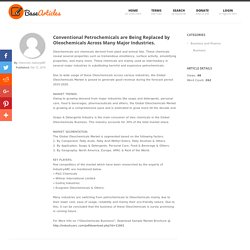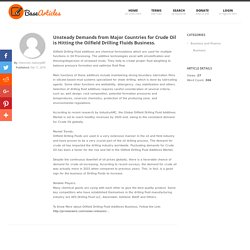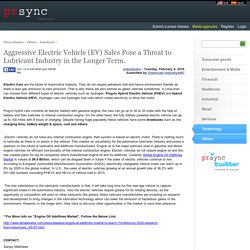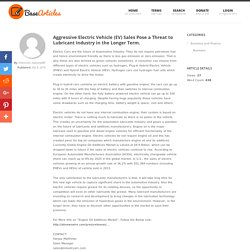

Oilfield Drilling Fluid Additives Market Estimated to Reach $2,323 Million By 2020 - Driven Mainly By Consistent Global Demand For Crude Oil. Oleochemicals are Being Used by Many Major Industries Replacing the Conventional Petrochemicals. Oleochemicals are chemicals derived from plant and animal fats.

These chemicals reveal several properties such as tremendous emolliency, surface activity, emulsifying properties, and many more. These chemicals are mainly used as intermediary in several major industries in substituting harmful and expensive petrochemicals. Due to wide usage of these Oleochemicals across various industries, the Global Oleochemicals Market is poised to generate good revenue during the forecast period 2015-2020. To Know More about “Global Oleochemicals Market, Download Sample Market Report: Conventional Petrochemicals are Being Replaced by Oleochemicals Across Many Major Industries. Oleochemicals are chemicals derived from plant and animal fats.

These chemicals reveal several properties such as tremendous emolliency, surface activity, emulsifying properties, and many more. These chemicals are mainly used as intermediary in several major industries in substituting harmful and expensive petrochemicals. Due to wide usage of these Oleochemicals across various industries, the Global Oleochemicals Market is poised to generate good revenue during the forecast period 2015-2020. MARKET TRENDS: Owing to growing demand from major industries like soaps and detergents, personal care, food & beverages, pharmaceuticals and others, the Global Oleochemicals Market is growing at a comprehensive pace and is estimated to grow more till the decade end.
Soaps & Detergents Industry is the main consumer of oleo chemicals in the Global Oleochemicals Business. Unsteady Demands from Major Countries for Crude Oil is Hitting the Oilfield Drilling Fluids Business. Oilfield Drilling Fluid additives are chemical formulations which are used for multiple functions in Oil Processing.

The additive technologies excel with emulsification and thinning/dispersion of oil-based muds. They help to create proper fluid weighting to balance pressure formation and optimize fluid flow. Main functions of these additives include maintaining strong boundary lubrication films in silicate-based mud systems specialized for shale drilling, which is done by lubricating agents. Some other functions are wettability, detergency, clay stabilization and others. Selection of drilling fluid additives requires careful consideration of several criteria, such as; well design, rock composition, potential formation pressures and temperatures, reservoir chemistry, protection of the producing zone, and environmental regulations. Aggressive Electric Vehicle (EV) Sales Pose a Threat to Lubricant Industry in the Longer Term.: Business Articles.
Electric Cars are the future of Automotive Industry.

They do not require petroleum fuel and hence environment friendly as there is less gas emission or zero emission. That is why these are also termed as green vehicles sometimes. Aggressive Electric Vehicle (EV) Sales Pose a Threat to Lubricant Industry in the Longer Term. Electric Cars are the future of Automotive Industry.

They do not require petroleum fuel and hence environment friendly as there is less gas emission or zero emission. That is why these are also termed as green vehicles sometimes. A consumer can choose from different types of electric vehicles such as hydrogen, Plug-In Hybrid Electric Vehicle (PHEV) and Hybrid Electric Vehicle (HEV).
Hydrogen cars use hydrogen fuel cells which create electricity to drive the motor. Aggressive Electric Vehicle (EV) Sales Pose a Threat to Lubricant Industry in the Longer Term. Electric Cars are the future of Automotive Industry.

They do not require petroleum fuel and hence environment friendly as there is less gas emission or zero emission. That is why these are also termed as green vehicles sometimes. A consumer can choose from different types of electric vehicles such as hydrogen, Plug-In Hybrid Electric Vehicle (PHEV) and Hybrid Electric Vehicle (HEV). Hydrogen cars use hydrogen fuel cells which create electricity to drive the motor. Plug-in hybrid cars combine an electric battery with gasoline engine; the cars can go up to 30 to 35 miles with the help of battery and then switches to internal combustion engine. Aggressive Electric Vehicle (EV) Sales Pose a Threat to Lubricant Industry in the Longer Term. New York, United States, February 09,2016/Free-Press-Release.com/ -- Electric Cars are the future of Automotive Industry.

They do not require petroleum fuel and hence environment friendly as there is less gas emission or zero emission. That is why these are also termed as green vehicles sometimes. A consumer can choose from different types of electric vehicles such as hydrogen, Plug-In Hybrid Electric Vehicle (PHEV) and Hybrid Electric Vehicle (HEV). Hydrogen cars use hydrogen fuel cells which create electricity to drive the motor. Plug-in hybrid cars combine an electric battery with gasoline engine; the cars can go up to 30 to 35 miles with the help of battery and then switches to internal combustion engine. Aggressive Electric Vehicle (EV) Sales Pose a Threat to Lubricant Industry in the Longer Term. Electric Cars are the future of Automotive Industry.

They do not require petroleum fuel and hence environment friendly as there is less gas emission or zero emission. That is why these are also termed as green vehicles sometimes. Metal Deactivator Market to Grow at a Moderate CAGR of 5.3% by 2020 - IndustryARC. PRFree.Org (Press Release) Feb 1, 2016 -- Formulated into two types, Oil Soluble and Water Soluble, Metal Deactivators are variants of fuel additives and oil additives that are used to stabilize fluids by disabling metal ions to make them inactive as oxidation catalysts.

They as well help to deactivate the transition metals which act as impurities in some mineral fillers and inorganic pigments. Though there are numerous applications of this market, the quantity of usage in each is noted to be less which is expected to cause the overall market for Metal Deactivators to be stagnant globally. IndustryARC suggests that the total market shall grow at a 5.3% CAGR during the forecast period, 2015-2020 to reach $207 Million with APAC region exhibiting the fastest growth. To Know More about “Metal Deactivator Market”, Follow the Below Report Link: REPORT SCOPE:Market Segmentation: The Metal Deactivator Market is segmented into 4 types broadly with further segmentations under the same.
Metal Deactivator Market to Grow at a Moderate CAGR of 5.3% by 2020 - IndustryARC, Business - weSRCH. Formulated into two types, Oil Soluble and Water Soluble, Metal Deactivators are variants of fuel additives and oil additives that are used to stabilize fluids by disabling metal ions to make them inactive as oxidation catalysts.

They as well help to deactivate the transition metals which act as impurities in some mineral fillers and inorganic pigments. Though there are numerous applications of this market, the quantity of usage in each is noted to be less which is expected to cause the overall market for Metal Deactivators to be stagnant globally. IndustryARC suggests that the total market shall grow at a 5.3% CAGR during the forecast period, 2015-2020 to reach $207 Million with APAC region exhibiting the fastest growth. To Know More about “Metal Deactivator Market”, Follow the Below Report Link: Prominent Industries and Applications: Metal Deactivator Market to Grow at a Moderate CAGR of 5.3% by 2020 - IndustryARC. Metal Deactivator Business to Remain Stagnant in Coming Years - IndustryARC. Metal Deactivator Business is bound to remain stationery in coming years due to less quantity of usage in its applications.
Formulated into two types, Oil Soluble and Water Soluble, Metal Deactivators are variants of fuel additives and oil additives that are used to stabilize fluids by disabling metal ions to make them inactive as oxidation catalysts. They as well help to deactivate the transition metals which act as impurities in some mineral fillers and inorganic pigments. Metal Deactivator Market to Grow at a Moderate CAGR of 5.3% by 2020 - For Press Release - Online Press Release Distribution Service. Formulated into two types, Oil Soluble and Water Soluble, Metal Deactivators are variants of fuel additives and oil additives that are used to stabilize fluids by disabling metal ions to make them inactive as oxidation catalysts. They as well help to deactivate the transition metals which act as impurities in some mineral fillers and inorganic pigments. Though there are numerous applications of this market, the quantity of usage in each is noted to be less which is expected to cause the overall market for Metal Deactivators to be stagnant globally.
IndustryARC suggests that the total market shall grow at a 5.3% CAGR during the forecast period, 2015-2020 to reach $207 Million with APAC region exhibiting the fastest growth. Metal Deactivator Market to Grow at a Uniform CAGR of 5.3% by Decade End - IndustryARC. Formulated into two types, Oil Soluble and Water Soluble, Metal Deactivators are variants of fuel additives and oil additives that are used to stabilize fluids by disabling metal ions to make them inactive as oxidation catalysts. They as well help to deactivate the transition metals which act as impurities in some mineral fillers and inorganic pigments. Though there are numerous applications of this market, the quantity of usage in each is noted to be less which is expected to cause the overall market for Metal Deactivators to be stagnant globally.
IndustryARC suggests that the total market shall grow at a 5.3% CAGR during the forecast period, 2015-2020 to reach $207 Million with APAC region exhibiting the fastest growth. Deactivator market News: Metal Deactivator Market to Grow at a Moderate CAGR of 5.3% by 2020 - IndustryARC. New York, United States, February 01,2016/Free-Press-Release.com/ -- Formulated into two types, Oil Soluble and Water Soluble, Metal Deactivators are variants of fuel additives and oil additives that are used to stabilize fluids by disabling metal ions to make them inactive as oxidation catalysts. They as well help to deactivate the transition metals which act as impurities in some mineral fillers and inorganic pigments. Though there are numerous applications of this market, the quantity of usage in each is noted to be less which is expected to cause the overall market for Metal Deactivators to be stagnant globally.
IndustryARC suggests that the total market shall grow at a 5.3% CAGR during the forecast period, 2015-2020 to reach $207 Million with APAC region exhibiting the fastest growth. Metal Deactivator Business to Remain Stagnant in Coming Years - IndustryARC - Exact Release 05:32 am. Return to: Business News Formulated into two types, Oil Soluble and Water Soluble, Metal Deactivators are variants of fuel additives and oil additives that are used to stabilize fluids by disabling metal ions to make them inactive as oxidation catalysts. They as well help to deactivate the transition metals which act as impurities in some mineral fillers and inorganic pigments. Though there are numerous applications of this market, the quantity of usage in each is noted to be less which is expected to cause the overall market for Metal Deactivators to be stagnant globally. IndustryARC suggests that the total market shall grow at a 5.3% CAGR during the forecast period, 2015-2020 to reach $207 Million with APAC region exhibiting the fastest growth.
To Know More about “Metal Deactivator Market”, Follow the Below Report Link: Press Releases. Less Usage of Metal Deactivators in terms of Quantity Lies as a Key Factor in the Moderate Growth of their Business. Metal Deactivator Business to Remain Stagnant in Coming Years. North America and Europe Stand as the Largest Markets for Scintillators - IndustryARC, Business - weSRCH. Scintillator Market to Reach $450 Million by 2020 due to Demand from Nuclear Power Industry - IndustryARC. Rise in Radiation Detection Technology is Pushing the Scintillator Market Ahead - For Press Release - Online Press Release Distribution Service.
Scintillator Market to Reach $450 Million by 2020 - IndustryARC. Scintillator market News: Rise in Radiation Detection Technology is Pushing the Scintillator Market Ahead - IndustryARC. Demand from Nuclear Power Plants is Pushing the Scintillator Market Ahead - IndustryARCDemand from Nuclear Power Plants is Pushing the Scintillator Market Ahead - IndustryARC - Exact Release 04:48 am. Scintillator Market to Reach $450 Million by 2020 - IndustryARC. Demand from Nuclear Power Plants is Pushing the Scintillator Market Ahead - IndustryARC · Issue #11 · chemicalsiarc/Chemicals-and-Materials-Market-Analysis. Rise in Radiation Detection Technology is Pushing the Scintillator Market Ahead - IndustryARC. 4shared.com - free file sharing and storage - Document Preview - text. Biofuel Additives Market by ChemicalsIARC - issuu.
Biofuel Additives Market Analysis and Forecast till Decade End. 4shared.com - free file sharing and storage - Document Preview - text. Biofuels Additives Market Analysis and Forecast till 2020. PowerPoint presentation. Biofuel Additives Market. Asia-Pacific Region is a Major Revenue Generating Source for Concrete Superplasticizers Market. Concrete Superplasticizers are Being Used More OFten in Costruction due to their High Water Reduction Ability.
Concrete Superplasticizers Market Estimated to Reach $25.5 Billion by 2020 - IndustryARC. Concrete Superplasticizers Market Estimated to Reach $25.5 Billion by 2020 - IndustryARC, Business - weSRCH. Asia-Pacific Region is a Major Revenue Generating Source for Concrete Superplasticizers Market. Concrete Superplasticizers are Being Used More OFten in Costruction due to their High Water Reduction Ability. Concrete Superplasticizers Market Estimated to Reach $25.5 Billion by 2020 - IndustryARC. Concrete Superplasticizers are Being Used More OFten in Costruction due to their High Water Reduction Ability. - Exact Release 04:27 am. Concrete Superplasticizers are Being Used More OFten in Costruction due to their High Water Reduction Ability. Concrete Superplasticizers Market to Reach 10.1 Million Tons in Production Volume by 2020 · Issue #8 · chemicalsiarc/Chemicals-and-Materials-Market-Analysis.
Asia-Pacific Region is a Major Revenue Generating Source for Concrete Superplasticizers Market. Ammonia Refrigerant Market. Ammonia Refrigerant Market Analysis and Forecast. Ammonia Refrigerant Market. 4shared.com - free file sharing and storage - Document Preview - text. Polycarbonate Resin Market is Racing Ahead due to Global Demand.: chemicalsiarc. Polycarbonate Resin Market to Reach 6.25 Million Tons in Production Volume by 2020. - Polycarbonate Resin; Specialty Material used in Various Major Industries; Business of these Resins is on the Rise. Polycarbonate Resin Market to Reach 6.25 Million Tons in Production Volume by 2020 - IndustryARC, Business - weSRCH. Polycarbonate Resin Market to Reach 6.25 Million Tons in Production Volume by 2020 - IndustryARC. Polycarbonate Resin Market to Reach 6.25 Million Tons in Production Volume by 2020 - IndustryARC.
Polycarbonate Resin Market to Reach 6.25 Million Tons in Production Volume by 2020 - IndustryARC. Polycarbonate resin News: Polycarbonate Resin Market to Reach 6.25 Million Tons in Production Volume by 2020 - IndustryARC. Polycarbonate Resin Market is Racing Ahead due to Global Demand - IndustryARC - Exact Release 02:04 am. Press Releases. Polycarbonate Resin Market Analysis. Polycarbonate Resin Market is Racing Ahead due to Global Demand - IndustryARC. Polycarbonate Resin; Specialty Material used in Various Major Industries; Business of these Resins is on the Rise. Polycarbonate Resin Market By Grade & By Application 2020. Biocides Market Analysis and Forecast till 2020. BIocides Market Analysis and Forecast till 2020. by ChemicalsIARC - issuu.
BIocides Market Analysis and Forecast till 2020. 4shared.com - free file sharing and storage - Document Preview - text. Sustainable Diesel Usage is Set to Push the Cetane Number Improver market to $825 Million by 2020., Business - weSRCH. Sustainable Diesel Usage is Set to Push the Cetane Number Improver market to $825 Million by 2020. Sustainable Diesel Usage is Set to Push the Cetane Number Improver market to $825 Million by 2020 - IndustryARC. Sustainable Diesel Usage is Set to Push the Cetane Number Improver market to $825 Million by 2020 - IndustryARC.
Sustainable Diesel Usage is Set to Push the Cetane Number Improver market to $825 Million by 2020 - IndustryARC. Cetane Number Improver Market. Cetane Number Improver Market is Poised to Grow due to Unending Usage of Diesel Engines. Increasing Demand for Diesel Vehicles is Driving the Cetane Number Improver Market to reach $825 million in sales by 2020. · Issue #6 · chemicalsiarc/Chemicals-and-Materials-Market-Analysis. Sustainable Diesel Usage is Set to Push the Cetane Number Improver market to $825 Million by 2020. Biocides Market Analysis; Trends and Forecast to 2020. PowerPoint presentation. Biocides Market to Increase due to Demand from Various Major Industries - IndustryARC. Food and Beverage Industry stand as the Second Major Application in Biocides Market - IndustryARC. Biocides Market Analysis. Food and Beverage Industry stand as the Second Major Application in Biocides Market. Biocides Market: Market Trends, Forecast till 2020; Market Segmentation by Application, End User, Geography.
Baby Care Industry in Superabsorbent Polymers Market holds Most of the Business Share - IndustryARC, Business - weSRCH. North America is the Largest Market for Superabsorbent Polymers followed by Europe - IndustryARC. Baby Care Industry in Superabsorbent Polymers Market holds Most of the Business Share - IndustryARC. Polymers market News: Superabsorbent Polymers Market is Expected to Grow at a CAGR 5.8% from 2015 to 2020 - IndustryARC.
North America is the Largest Market for Superabsorbent Polymers followed by Europe - IndustryARC - Exact Release 12:13 am. Baby Care Industry in Superabsorbent Polymers Market holds Most of the Business Share - IndustryARC. Superabsorbent Polymers Market. Baby Care Industry in Superabsorbent Polymers Market holds Most of the Business Share. Superabsorbent Polymers Market is Expected to Grow at a CAGR 5.8% from 2015 to 2020. · Issue #4 · chemicalsiarc/Chemicals-and-Materials-Market-Analysis. Composite Materials Market to Reach $36 Billion by 2020 - IndustryARC. Composite Materials Market to Reach $36 Billion by 2020 - IndustryARC · Issue #2 · chemicalsiarc/Chemicals-and-Materials-Market-Analysis. Mining Chemicals Industry to Grow at a CAGR of 6.72% by 2020 - IndustryARC, Business - weSRCH.
Mining Chemicals Market to Reach $30.41 Billion by 2020 - IndustryARC. Chemicals market News: Mining Chemicals Market to Surpass $30 Billion in Revenue by 2020 - IndustryARC. Mining Chemicals Market to Reach $30.41 Billion by 2020 - IndustryARC - Exact Release 02:15 am.